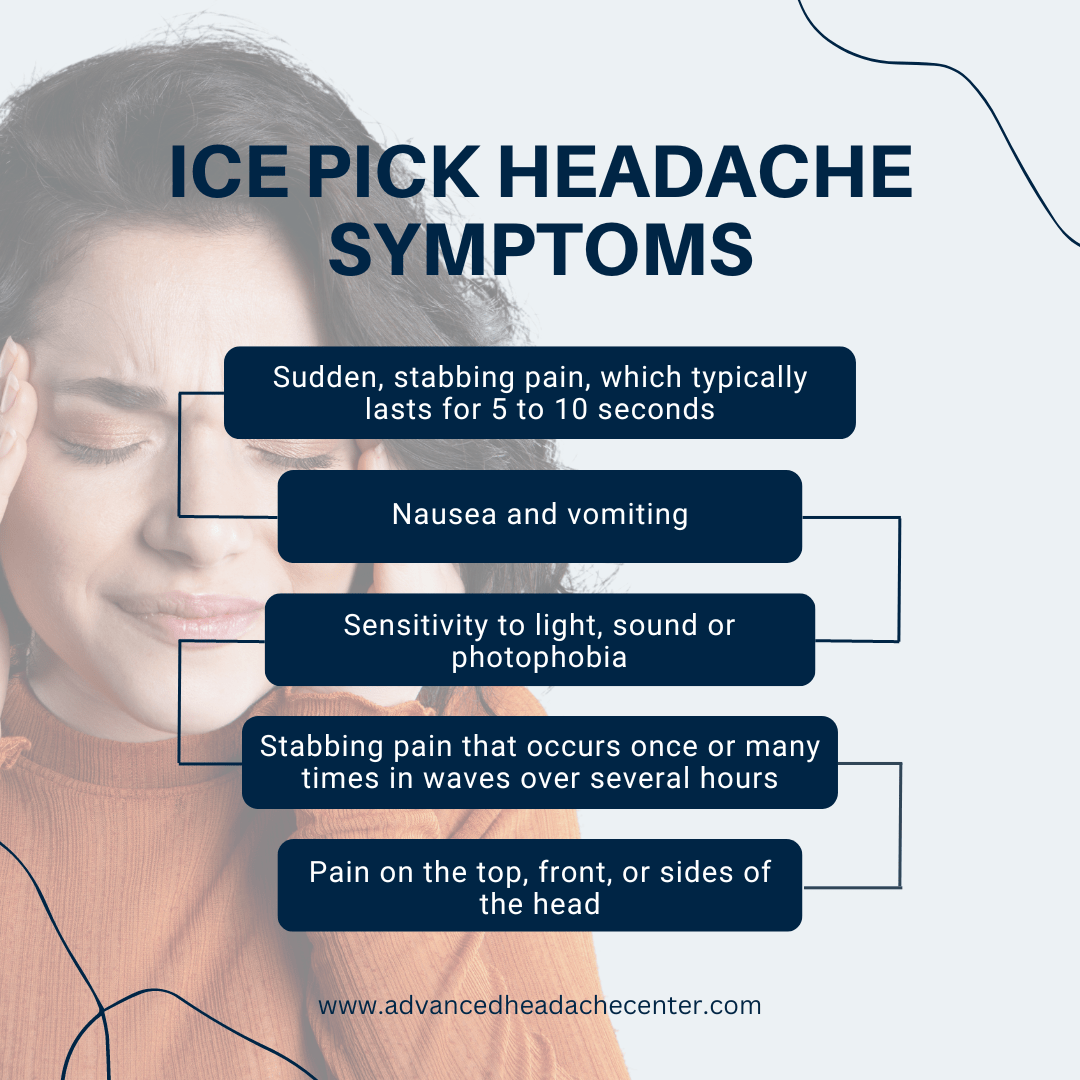Getting attacked by extremely intense pain that feels like you are being stabbed with an ice pick is a very unpleasant situation and disrupts your normal life. Seeking help from an expert pain doctor is necessary to have this condition diagnosed and treated. The specialists at Advanced Headache Center will determine the reasons behind the pain and come up with a tailored treatment plan to help you live better.
Ophthalmodynia periodica, more commonly known as ice pick headache, is identified by a sensation in the head that feels as if you are being stabbed with an ice pick. The painful, severe headache comes on suddenly and is best described as a stabbing blow or series of stabs from an ice pick. The pain occurs without warning and lasts no longer than a minute. It can happen once to several times a day while you are awake or sleeping.
Ice pick headache is different from migraine or cluster headaches but causes excruciating pain within no time. If you experience ice pick headaches frequently and the attacks occur more than once a day, seek help from headache experts who can offer the best solution for your condition. With the most advanced diagnostic equipment and a multidisciplinary approach, a licensed doctor will ensure you get the best relief treatment.
[callPoint]
Types of Ice Pick Headaches
There are two different types of ice pick headaches:
- Primary stabbing headache where the ice pick headache is the problem; no underlying problem is causing it
- Secondary stabbing headache means there is an underlying or secondary cause of the ice pick headache. This condition can be treated to provide relief or control the frequency of attacks.
Successful treatment for ice pick headache depends largely on an accurate diagnosis of the problem. The pain management doctor can get to the bottom of the problem and help you find the best way to keep the pain away.
Ophthalmodynia Periodica Causes – What Triggers Ice Pick Headaches
The cause of primary ice pick headaches remains a mystery for researchers, but they are believed to be associated with temporary and short-term disruptions within the brain’s central pain control mechanisms. People who get migraines or cluster headaches get ice pick headaches more frequently than an average person.
Some common causes include:
- Stress
- Changes in sleeping habits
- Bad quality sleep or lack of sleep
- Skipping meals and staying hungry for long hours
- Specific foods such as processed meats that contain nitrate, which is known for causing migraine
Primary ice pick headaches do not occur for any apparent cause, but, secondary ice pick headaches mean some underlying medical condition is causing the pain, and this headache is a symptom.
Other triggers and risk factors for ice pick headaches include:
- History of migraine
- Bell’s palsy
- Shingles
- Multiple sclerosis
- Pituitary tumor
- Changes in weather
- Lack of sleep
- Bright lights
- Posture changes
- Emotional stress
- Eating ice cream or drinking a cold drink
Ice pick headaches are not dangerous, but recurring stabbing pain in the eye or sharp pain at the top or head or back of the head can be debilitating and prevent you from living a full life. Tracking your triggers is a good idea to know more about these headaches and why they occur. You can discuss these triggers with the doctor who will suggest the right treatments based on lifestyle changes and relaxation therapy to help you seek relief.
Ice Pick Headache Symptoms – What You Might Be Going Through
Symptoms of primary stabbing headache can be similar to those of migraine or cluster headaches as the pain is intense, occurs over some time, and ranges from weeks to months.
Symptoms of ice pick headache include:
- Sudden, stabbing pain, which typically lasts for 5 to 10 seconds
- Nausea and vomiting
- Sensitivity to light or photophobia
- Sensitivity to sound or phonophobia
- Stabbing pain that occurs once or many times in waves over several hours
- Pain on the top, front, or sides of the head
The duration of the pain might be short, but it can be categorized as moderately severe to extremely painful. The stabs can occur once or many times in waves over several hours, which is a cause for concern.
It is important to discuss your ophthalmodynia periodica symptoms with a pain doctor who will make an accurate diagnosis based on your information and recommend the appropriate treatment. Ice pick headaches are not dangerous, but they can affect your life with recurring pain.
Secondary stabbing headaches can result from another headache disorder and cause symptoms that are similar to ice pick headaches.
These disorders can include:
- SUNCT or Short-lasting, unilateral, neuralgiform headaches and conjunctival injection (redness on the white part of the eye) and tearing
- Herpetic neuralgia caused by a recent bought of shingles or chickenpox
- SUNA or Short-lasting unilateral neuralgiform headaches and cranial autonomic symptoms
- Occipital neuralgia
- Trigeminal neuralgia
- A nummular headache
Ruling out these conditions is very important to diagnose primary stabbing headaches and their causes. Your doctor might use a variety of tests to determine conditions that lead to ice pick headache symptoms.

[callPoint]
Ophthalmodynia Periodica Treatment
Treating ice pick headaches often becomes difficult because the attacks are brief, and they are usually over before you can take medication. However, if you suffer more than one attack during the day, it might be necessary to seek medical help to avoid the excruciating pain and its effect on your daily life. Once the causes of your ice-pick headache have been diagnosed by a top pain doctor, he will recommend the best treatment.
Doctors usually recommend medications to prevent frequent primary ice pick headache attacks or, in rare cases, when the headache lasts longer than a couple of days.
The medicines include:
- Non-steroidal anti-inflammatory drug (NSAID) Indomethacin
- Melatonin
- Gabapentin
- Nifedipine
- Paracetamol
- Celecoxib
It is essential to use these medicines as per the doctor’s advice as they can cause side effects like nausea, vomiting, dizziness, and drowsiness that lead to further complications. Do not let these headaches affect your health and wellbeing, as the headache specialists will come up with treatment options to provide quick and lasting relief.
If you are suffering from brief headaches that feel like stabs, consult your doctor to rule out underlying health conditions. The Advanced Headache Center relies on the most advanced diagnostic equipment to come up with a precise diagnosis. The doctor will conduct tests including physical exam, medical history, and x-rays to offers a range of solutions for your discomfort. As you learn more about your symptoms and causes, the pain management doctor will keep an eye on your progress and modify the treatment plan as required to help you live a better quality of life.




